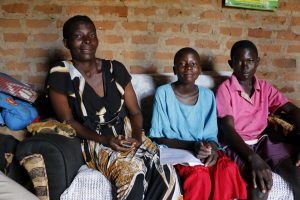 Rebecca Mukyala, a 48-year old single mother of two, keeps the key to the community warehouse — built by WFP in Nambaale sub-county in eastern Uganda in 2015. She is the marketing manager of a group of over a thousand small-scale farmers who jointly manage the premises. Roughly half of them are female heads of households.
Rebecca Mukyala, a 48-year old single mother of two, keeps the key to the community warehouse — built by WFP in Nambaale sub-county in eastern Uganda in 2015. She is the marketing manager of a group of over a thousand small-scale farmers who jointly manage the premises. Roughly half of them are female heads of households.
During the harvest season the warehouse opens every day, with group members bringing their dried crops, some from as far as 10 kilometres away. The farmers who live closest to the 300-metric-ton-capacity structure are responsible for keeping the warehouse and its surroundings clean. The sub-county provides policemen who guard it at night.
“Before we stored our grain in that youth centre,” Rebecca says, pointing at a grey concrete building with lots of windows. “But we lost much of it to rodents and rain water. With this warehouse we don’t encounter any such losses.”
WFP has built or subsidized 70 similar warehouses in 40 districts in Uganda as part of a wider effort to assist the government address root causes of hunger using market-driven solutions. Small-scale farmers in the country are at particular risk of hunger due to their low crop production combined with high post-harvest losses.
WFP’s development programme is addressing these challenges by improving farmers’ skills, building infrastructure, subsidizing modern storage equipment and providing a market for quality grain. All contributing to farmers being able to grow enough surplus crops to sell and earn a decent living to provide for their families.
The warehouses act as agricultural business hubs with WFP’s NGO partners and the district local government training farmers in agronomic skills, governance, financing, value addition, warehouse management (including quality control) and business planning. The farmers can also access inputs and group loans and have the opportunity to bulk and market their grain together, getting a better price for their crops. Buyers wanting to buy grain in bulk also now know where to come.
Click here for the full story.
originally published on the WFP website.




